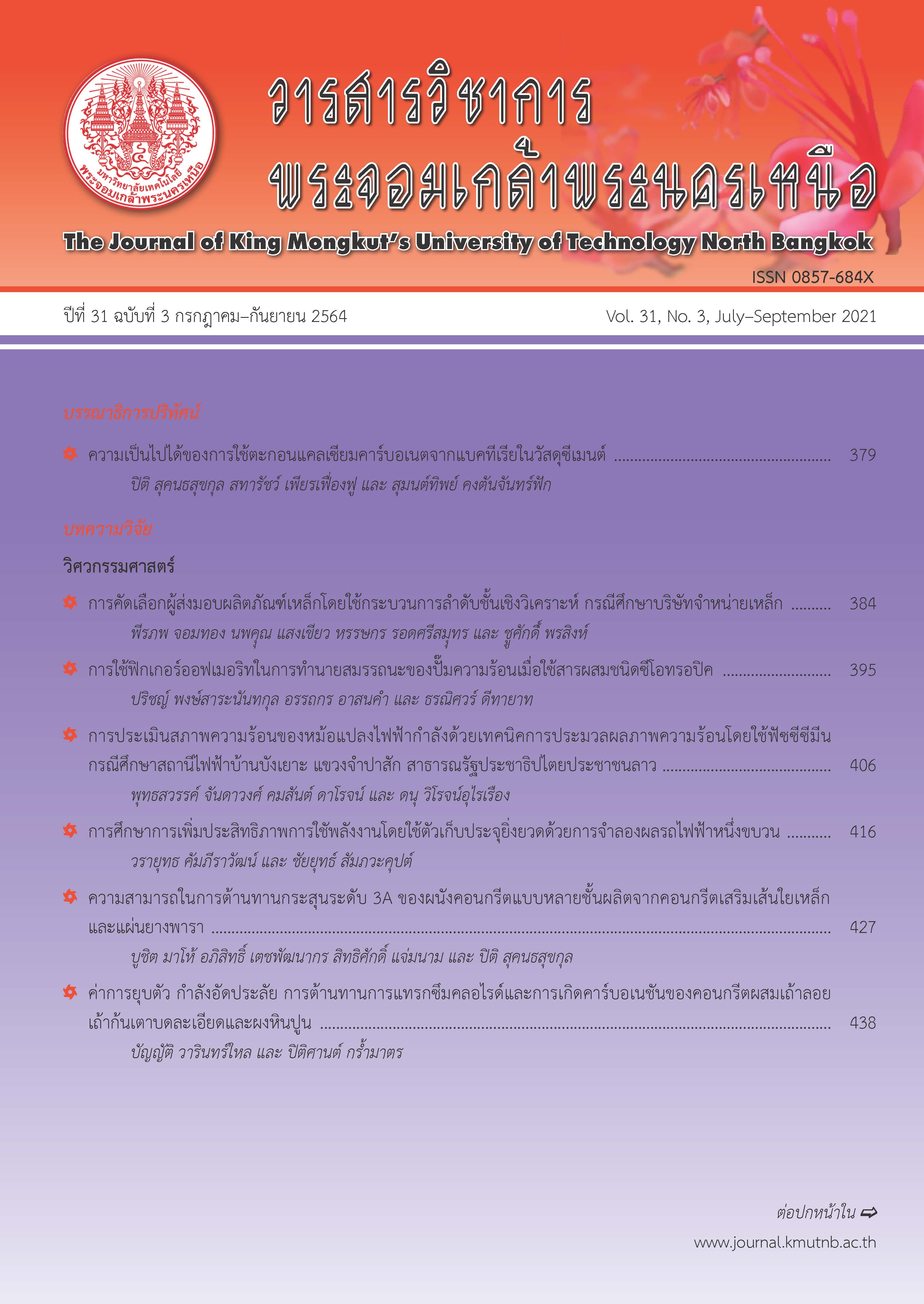พฤติกรรมเสาคอนกรีตที่มีกำลังอัดต่ำเสริมกำลังโดยวิธีการโอบรัดด้วยเหล็กแผ่นเหนียวอัดแรงภายหลัง
Main Article Content
บทคัดย่อ
งานวิจัยนี้ศึกษาประสิทธิภาพของระบบเสริมกำลังโดยวิธีการโอบรัดด้วยเหล็กแผ่นเหนียวภายใต้แรงอัดแบบเยื้องศูนย์ มีวัตถุประสงค์เพื่อทำการศึกษาประสิทธิภาพของการเสริมกำลังเสาคอนกรีตกำลังอัดต่ำโดยวิธีการโอบรัดด้วยเหล็กแผ่นพืดกำลังสูง โดยแบ่งช่วงการทดสอบออกเป็น 2 ระยะ คือระยะที่ 1 ทำการทดสอบประสิทธิภาพการเสริมกำลังตัวอย่างคอนกรีตรูปทรงกระบอกที่มีกำลังอัดประลัยต่ำ (15 MPa) จากการศึกษาพบว่าตัวอย่างที่มีการรัดรอบโดยมีระยะห่างการรัดรอบเท่ากับ 0 มีค่ากำลังอัดประลัยเพิ่มขึ้นร้อยละ 262 และมีค่าดัชนีประสิทธิภาพเท่ากับ 1.655 ซึ่งนำมาใช้ในการเสริมกำลังเสาคอนกรีตกำลังประลัยต่ำจำนวน 12 ตัวอย่าง ในระยะที่ 2 ภายใต้แรงอัดแบบเยื้องศูนย์ ซึ่งผลจากการศึกษาพบว่าการเสริมกำลังเสาคอนกรีตกำลังอัดต่ำด้วยวิธีการโอบรัดด้วยแผ่นเหล็กเหนียวมีผลต่อการเพิ่มความสามารถในการรับโมเมนต์ดัดของเสาน้อยมากจนไม่มีนัยสำคัญ แต่เมื่อเปรียบเทียบกับความสามารถในการรับน้ำหนักของเสาตามแนวแกนที่เพิ่มขึ้นคิดเป็นร้อยละ 28 และอิทธิพลการรัดรอบเสาทดสอบด้วยวิธีการเสริมกำลังดังกล่าว พบว่าการเสริมกำลังเสาคอนกรีตกำลังต่ำโดยโอบรัดด้วยเหล็กพืดกำลังสูงสามารถเพิ่มความสามารถในการรับน้ำหนักบรรทุกตามแนวแกนอย่างมีนัยสำคัญ โดยแปรผันตามจำนวนชั้นของการรัดรอบด้วยแผ่นเหล็กเหนียว
Article Details
บทความที่ลงตีพิมพ์เป็นข้อคิดเห็นของผู้เขียนเท่านั้น
ผู้เขียนจะต้องเป็นผู้รับผิดชอบต่อผลทางกฎหมายใดๆ ที่อาจเกิดขึ้นจากบทความนั้น
เอกสารอ้างอิง
[2] B. J. Bett, R. E. Klingner, and J. O. Jirsa, “Lateral load response of strengthened and repaired reinforced concrete columns,” ACI Structural Journal, vol. 85, no. 5, pp. 499–508, 1988.
[3] Y. H. ChaiI, M. J. N. Priestley, and F. Seible, “Seismic retrofit of circular bridge columns for enhanced flexural performance,” ACI Structural Journal, vol. 88, no. 5, pp. 572–584, 1991.
[4] M. Frangou, K. Pilakoutas, and S. Dritsos, “Structural repair strengthening of RC columns,” Construction Building Materials, vol. 9, no. 5, pp. 259–266, 1995.
[5] M. Frangou, “Strengthening of concrete by lateral confinement,” Ph.D. thesis, Department of Civil and Structural Engineering, The University of Sheffield, UK, 1996.
[6] T. Imjai, U. Chaisakulkiet, R. Garcia, and K. Pilakoutas, “Strengthening of RC members using post-tensioned metal straps: State of the research,” Lowland Technology International Journal, vol. 20, no. 2, pp. 187–196, 2018.
[7] C.K. Ma, A.Z. Awang, W. Omar, M. Liang, S.W. Jaw, and M. Azimi, “Flexural capacity enhancement of rectangular high-strength concrete columns confined with post-tensioned steel straps: Experimental investigation and analytical modelling,” Structural Concrete Journal of the Fib. vol. 17, no. 4, pp. 668–676, 2016.
[8] B.M. Johnson and A.H. Wilson, Building Code Requirements for Structural concrete and Commentary. Terminology of Building Conservation Industry, Division of Building Research, NRC Canada, ACI 318-14, 2015.
[9] Commission of the European Communities, “Eurocode No. 8: Structures in seismic regionsdesign part 1. generala and building,” Report EUR 12266 EN, May 1988.
[10] E. C. Bentz, “Sectional analysis of reinforced concrete,” Ph.D. thesis, Department of Civil Engineering, University of Toronto, 2000.
[11] F.J. Vecchio and M.P. Collins, “The modified compression field theory for reinforced concrete elements subjected to shear,” ACI Journal, Proceedings, vol. 83, no. 2, pp. 219–231, 1986.
[12] F. J. Vecchio and M. P. Collins, “Compression response of cracked reinforced concrete,” ASCE Journal of Structural Engineering, vol. 119, no. 12, pp. 3590–3610, 1993.
[13] T. Imjai, M. Setkit, R. Garicia, and F. Figueiredo, “Flexural strengthening of damaged low strength concrete beams using PTMS and/or NSM techniques,” Case Studies in Construction Materials, in press, 2020.

